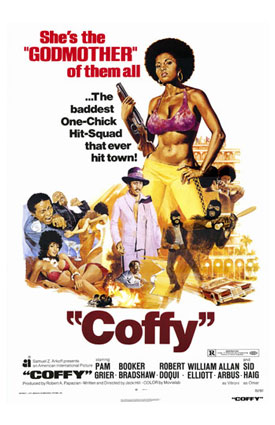What you see, above—an Italian 4-fogli, or four-sheet, for the 1973 film, Coffy—is, for its subject, size, and graphical power, to me, the single most desirable ephemeral object in all of Black film, and possibly connected to any movie.
Why?
To begin, check out its measurements, kiddies—and, here, the artwork impossibly outdoes its subject’s, actor Pam Grier’s, own astounding dimensions: The piece is 78″ x 55″. That’s 6 1/2 feet high by over 4 1/2 feet wide.
 Simply put, the Italians do not mess around when it comes to their street graphics. Presumably, when you’re moving past a whitewashed wall in a speeding Alfa Romeo convertible or, clutch my pearls, Ferrari Enzo, right, you’ve got to be able to quickly make sense of what you’re seeing, and you’ve gotta be able to read it, visually, at a distance.
Simply put, the Italians do not mess around when it comes to their street graphics. Presumably, when you’re moving past a whitewashed wall in a speeding Alfa Romeo convertible or, clutch my pearls, Ferrari Enzo, right, you’ve got to be able to quickly make sense of what you’re seeing, and you’ve gotta be able to read it, visually, at a distance.
“Many of our clients prefer the foreign poster for American films,” says Robert Chisolm, whose company, Chisolm Larsson Gallery, owns the object. “Quite often, the artwork is more interesting, having an over-the-top, dynamic quality.”
 True, indeed: If you’re familiar with the American, 27″ x 40″ one-sheet for Coffy, right, you’ll easily recognize the Italian poster’s heritage. The dominant central image in the poster of Grier—sporting a warlike afro, gold hoop earrings, skin tight leather pants, a straining pink halter top, and brandishing a macho, sawed-off shotgun—was extrapolated from its original art, and the hell-raising, cacophonous visual images in the lower half of the oil.
True, indeed: If you’re familiar with the American, 27″ x 40″ one-sheet for Coffy, right, you’ll easily recognize the Italian poster’s heritage. The dominant central image in the poster of Grier—sporting a warlike afro, gold hoop earrings, skin tight leather pants, a straining pink halter top, and brandishing a macho, sawed-off shotgun—was extrapolated from its original art, and the hell-raising, cacophonous visual images in the lower half of the oil.
In the new setting, though, the figure of Grier is simply framed against a white background, and encircled with a deft orange halo and complementary line art. “This subtle detailing makes the poster really pop,” says Chisolm. Meanwhile the title of the film, grown to one-quarter the new poster’s size, forms the image’s massive bottom section and base.
 In Eroi di Mille Leggende [Heroes of a Thousand Legends] (Grafis Ediz 1993), writer Franco La Polla says “the art of the cinematographic poster” can be described as “concentrating a whole image, an entire plot, to reassume, in one figure, all the others.” In the same book, erotic illustrator Milo Manara (“The Nose on the Poster”), right, speaks to the awe with which these works filled him as a child, describing the poster’s protagonists as “heroes shown in their finest gestures.”
In Eroi di Mille Leggende [Heroes of a Thousand Legends] (Grafis Ediz 1993), writer Franco La Polla says “the art of the cinematographic poster” can be described as “concentrating a whole image, an entire plot, to reassume, in one figure, all the others.” In the same book, erotic illustrator Milo Manara (“The Nose on the Poster”), right, speaks to the awe with which these works filled him as a child, describing the poster’s protagonists as “heroes shown in their finest gestures.”
Film poster art, then, has historically played a powerful role in the imaginations of postwar moviegoers, notes Italian critic Sergio Naitza, in his 1997 essay, “The Icons of Desire.” Keep in mind that
There were no video cassettes, twenty or twenty five years ago and the TV didn’t swallow and throw out films in rapid succession, every hour. Now they are shown obsessively, until they are consumed, ruining the mysterious chemistry, the image of a film. Then, you could only trust the poster, to re-savour the exciting rustle of that film that you had enjoyed so much and cried over, which had fascinated and worried. The poster was the only transport for the journey that had begun, the secret door towards another reality, that you could just perceive, a boiling of humours and vibrations. It was a promise of seduction, it was a bait to which your [feeling], hearing, and sight took; the poster called you to a malicious complicity, it knocked you back with a magnificent title that never maintained what it promised, it enchanted you with its bold colours and its big rough design, sulphur-like, and electricising, or unusually striking, original, and refined.
Seeing the American Coffy poster at the age of nine, before I knew anything at all about girls (not to mention women [my wife, Zakiya, would probably say I still don’t]), there was something almost gravitationally radiant about Grier’s austere sexuality, signified not only by the defiant, almost weapon-like stance of her breasts, or the actual firearm she cradles like a suckling infant, but her “I dare you” glare, and the casually-at-ready posture of her left hand upon her hip.
As Naitza says so well, though, the films never maintained what they promised. Not only is Coffy, the movie, right, merely “interesting” to me—hardly as gripping as this single artifact, despite Grier’s big, topless reveal, early on—but the movies whose posters I most love are rarely the movies I love most, and vice versa.
In the end, though, unlike the movie, “If you close your eyes and then open them again,” Naitza adds, “you will always find the object of your love in front of you, while the film moves, continues and automatically is transformed.”
Coffy Italian 4-fogli, 79″ x 55″, very good cond., $1,200, chisholm-poster.com.


1 comment so far ↓
I love this poster! Simplified and enlarged. It’s impact is incredible.
Leave a Comment